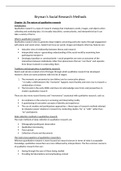Summary
Summary Bryman's Social Research Methods, ISBN: 9780198796053 Methods of Qualitative Research
- Course
- Institution
- Book
This document is a summary of chapters from the book “Bryman's social research methods” (6th edition) that is part of the material to be learned for the course “Methods of Qualitative Research”. The chapters are not chronological, but in the order in which they are discussed in the correspo...
[Show more]





